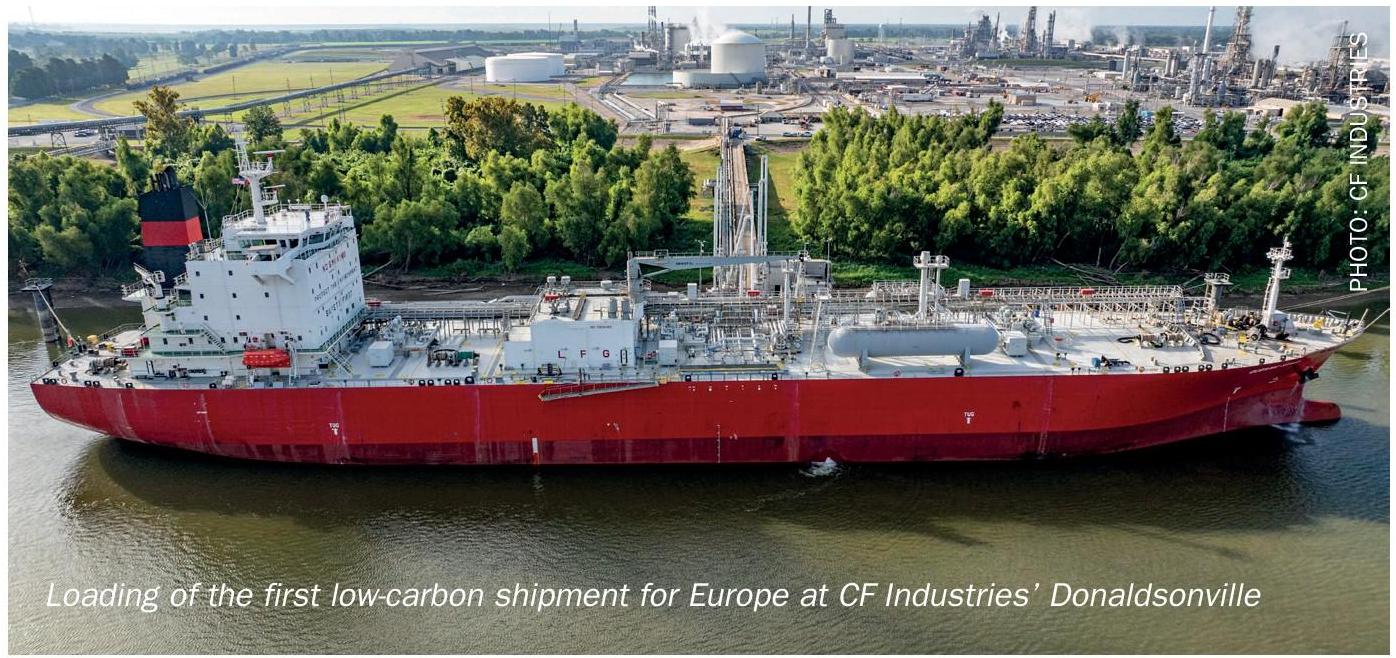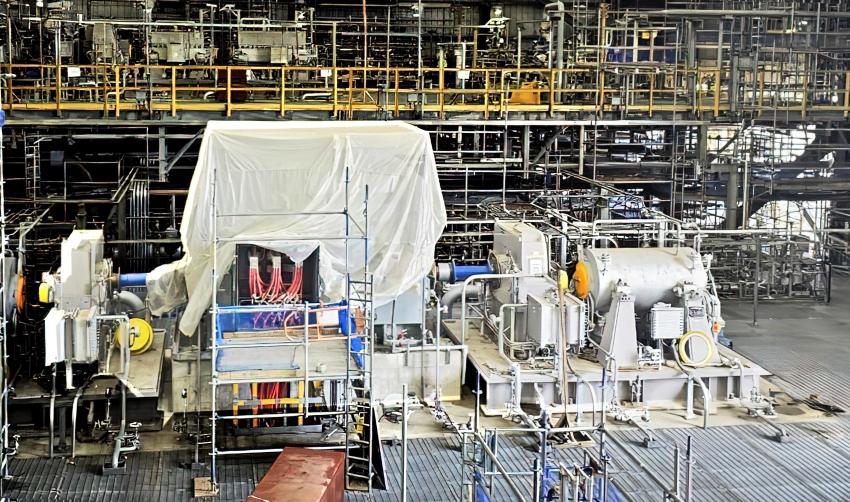Nitrogen+Syngas 396 Jul-Aug 2025

15 July 2025
IMTOF 2025
CONFERENCE REPORT
IMTOF 2025
This year’s International Methanol Technology Operators’ Forum (IMTOF) was held at the Holiday Inn Regents Park hotel, London, from June 15 to 18.

Johnson Matthey, fresh from their announcement of a sale of their catalysts business to Honeywell (see Syngas news, this issue), ran their biannual IMTOF meeting in London in early June. JM’s Alberto Giovanzana, giving the keynote address, noted that the participants in the room between them represented 24 million t/a of methanol production worldwide, just under one quarter of all methanol produced, and a majority of production outside of China. From JM’s perspective, that was also 11,000 cubic metres of installed catalyst. Methanol production continues to see rapid expansion, with the recent start-up of Methanex’s Geismar III plant in Louisiana, and its continued progress as a low carbon marine fuel. JM has sold seven licenses for renewable methanol plants in the past year.
Methanol markets
Mark Berggren, formerly of Methanol Market Services Asia, now under the Energy Aspects banner, as usual gave the main methanol market presentation. China continues to dictate the global methanol market, with Asia ex-China also seeing significant growth. There was a price run up in methanol markets in 4Q 2024 due to unplanned downtime for Atlantic Basin plants and some uncertainty over US tariffs, but spot methanol prices have dropped 35-40% this year as Chinese thermal coal prices fall and supply is relatively healthy while the demand outlook is slightly weaker. However, geopolitics continues to add ‘noise’ to markets, with the potential for disruption of Iranian exports to China in the wake of the recent conflict with Israel and the US, vessel restrictions at Chinese ports, and the complications of US export licenses to China. Crude oil prices are rising in Q3 2025 due to low inventories, but the upside is limited by growth in OPEC+ production as production restrictions are eased.
China and Asia in general will be responsible for 75% of demand growth over the next few years. Chinese growth is slowing but still dominates, while India and Southeast Asia are seeing higher growth. Uses of methanol are diversifying and MTO is no longer the sole driving factor, with considerable growth in conventional chemical derivatives and biodiesel. Methanol fuel uses are still waiting on regulatory developments, but even so another 17 million t/a of methanol is expected to be required over the next 5 years. However, Chinese MTO demand continues to set the price cap (around $300/t). Chinese c.fr prices are expected to rise through 2025, limited by olefins economics, but prices sufficient to justify new investment are required. In the absence of gas-based projects, Chinese coal-based projects may fill any supply gap that emerges. Gas supplies are becoming an issue for several major producers and exporters, including Trinidad, Chile, Iran, Malaysia, Brunei, Egypt and Turkmenistan.
Simon Maddren of Energex Partners also looked at methanol market trends. On the supply side, cheap US gas has underpinned the competitiveness of US methanol exports, but elsewhere, gas prices are rising due to increased LNG demand growth. Places such as Trinidad and Equatorial Guinea are seeing methanol have to compete with LNG exports for gas feedstock. Foreign investment in China is down to a fraction of what it was, and Chinese ‘Belt and Road’ outflows of investment are also well past their peak as China begins to invest more inwardly and decouples from major investment partners. China may add 30 million t/a of new domestic methanol production over the next 10 years, and Chinese coal prices are expected to stabilise the methanol floor price. Outside of China, many new projects may fall short of final investment decisions, aside from the US Gulf, which remains an attractive location.
Policy targets and regulations are driving new low carbon methanol demand growth, but may need to adapt and evolve to mitigate the risk of slippage. China actually represents one third of new low carbon methanol projects, using biomass. Overall, Energex sees 16 million t/a of low carbon methanol production by 2035, destined for major shipping companies. The potential demand for methanol-fuelled vessels could be even larger. Methanol based on hydrogen from electrolysis is further up the cost curve however, and may need biomass-based methanol to pave the way before it sees major investment money.
A panel discussion on the Tuesday drew together some of these strands. Methanol has considerable advantages as a low carbon shipping fuel compared to some of its competitors. Ammonia still faces regulatory hurdles, and some end users, such as shipping lines, remain extremely concerned about its toxicity. LNG meanwhile is not necessarily going to be available as a bunker fuel in some of the destinations that cruise ships visit, although around 2/3 of all bunkering takes place in the top five ports – Singapore, Rotterdam etc. Meanwhile battery powered vessels are also attracting interest for inshore or riverborne uses. But methanol still seems to have the advantage for now. Initial growth for low carbon methanol seems to be focusing on biomass – cooking oil, municipal waste, agricultural waste etc, but the panel acknowledged that this was a limited feedstock pool for large-scale applications, and the industry will need to move to carbon capture and storage/use and green methanol in the longer term. While e-methanol can be costly, for end uses like car parts etc, the incremental cost of having green plastics as opposed to fossil fuel-based ones is trivial compared to the value of the product, and indeed may add more value to consumers than the extra cost.
Transforming methanol production
A number of papers by JM highlighted their approach to the changing methanol market. Charles Yiu of JM described how large-scale designs have paved the way for sustainable methanol production, reviewing JM’s portfolio of rectors, including the radial steam raising converter, tube cooled converter, and axial steam raising converter, differing loop configurations, and catalyst combinations, including the most recent eMERALD simple synthesis loop for e-methanol production, first installed in a 10 t/d demonstrator plant for CRI in 2010, and with commercial scale units expected to be on-stream in the next few years.
John Swinney of JM presented the Enhanced Series Loop (ESL), designed to maximise the benefits of the company’s new generation catalysts. The ESL is a low circulation ratio loop, which with previous generation catalysts would have resulted in lower syngas efficiency. However, the improved activity and stability of the new generation catalysts means that the ESL can achieve comparable syngas efficiency to the Series loop, with the additional benefits of a simpler loop design, lower catalyst volume and improved heat recovery resulting in increased steam export.
Mark Kent of JM showcased the company’s range of promoted methanol synthesis catalysts, tailored to meet specific customer requirements, and offering significant improvements in long-term activity retention versus current generation unpromoted catalysts.
JM’s Kathryn Coxon meanwhile examined using JM’s eMERALD e-methanol technology for producing sustainable aviation fuels (SAF) via Honeywell UOP’s eFining methanol to olefins technology.
Digitalisation
Traditionally, methanol process plants have been designed, operated and simulated for continuous steady-state operation. For methanol process plants that operate on renewable feedstock and energy, the inherent intermittency caused by the variation in wind and/or solar power due to weather conditions can cause issues with the plant operation. Alan Faulkner of JM looked at this issue via deterministic dynamic simulation and advanced stochastic approaches.
Julien Grosclaude of Rely Solutions, a developer of green hydrogen and power-to-X systems, showcased his company’s digital tool Odyssey for optimising the configuration of renewable plants with reference to several case studies.
Operator experiences
Several operators also presented case histories of issues experienced. Methanex reported on an incident at its Damietta plant in Egypt in 2019 when a 110 barg (1,595 psig) superheated steam coil outlet header ruptured, producing an instantaneous release of high-pressure steam. The failure occurred after eight years in service, and without any prior indications. The failure mechanism was determined to be stress relaxation cracking adjacent to the longitudinal seam weld, which resulted in a large ‘window’ torn out of the side of the header. The initial investigation focused on the materials and fabrication of the header, but deeper analysis highlighted that code compliance does not always equate to fit for service.
Proman described a similar incident at a methanol plant in Trinidad within its main synthesis loop, which featured a pair of radial-flow steam raising converters. Subsequently, two issues within the synthesis loop were identified: internal gas bypassing and uneven feed gas distribution. Internal inspections confirmed that circumferential cracks on the top of the outlet collector shroud was the cause of internal gas bypassing. To mitigate the effects of this, a specially designed protective sealing blanket was designed, manufactured, and installed.
Natgasoline experienced a seven-week outage in November 2023, and a plant trip in January 2024. A root cause analysis revealed a yellow dust-like deposit in some water-cooled reactor tubes, while other tubes had outages of as much as three feet (0.9 m) from the top of the tube sheet to the catalyst. The direct cause of the differential pressure experienced was failure of the bottom mesh screen on the gas-cooled reactor (GCR), which triggered migration of inert support media throughout the synthesis loop with eventual disintegration and deposition in the WCR, leading to outage variances and flow restriction.
Munira al-Amri of OQBI in Oman and Barinder Ghai of Alleima both concentrated on reactor exit pigtails and the importance of materials selection to reduce the incidence of creep-related corrosion, as well as methodologies for estimating service life, while Kobus Harmse of OMC compared different methods of cleaning a steam reformer convection section.
There was also experience from green methanol plants. Marcelo Daller of HIF gave an overview of the Haru Oni plant which uses renewable hydrogen and recovered biogenic CO2, covering plant configuration, renewable energy integration, thermal design, and organisational structure, as well as ongoing development projects, including differences in feedstock management, heat integration and operational flexibility.
SUNGAS renewables is using gasified biomass to produce green methanol at its 500,000 t/a Beaver Lake facility in North America, currently in the front-end engineering design stage and expecting a final investment decision in 2026.






